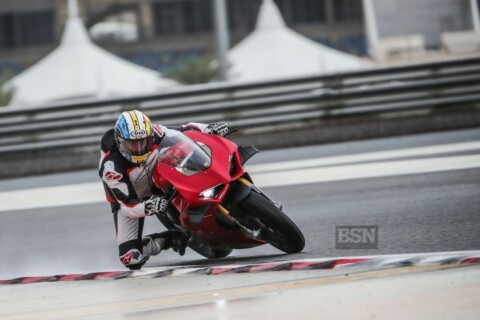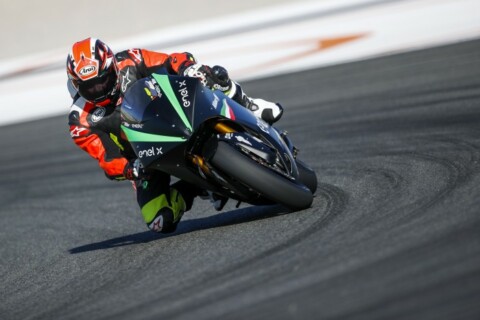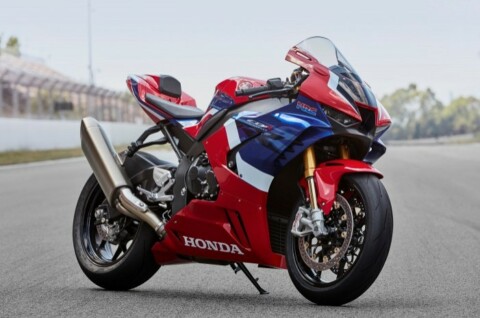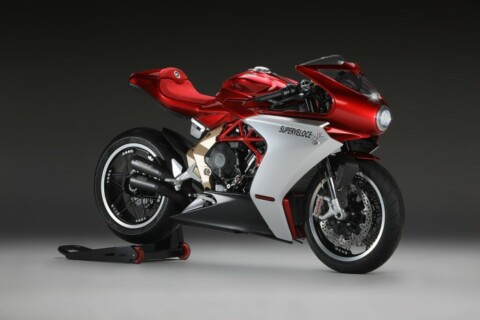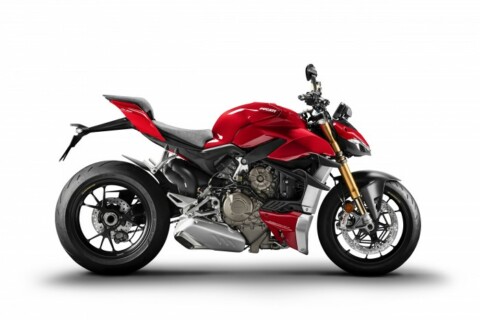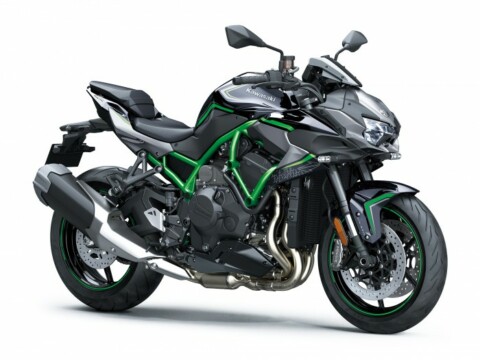Yamaha took the wraps off brand new YZF-R1 and R1M models at the Laguna Seca WorldSBK round and here are the highlights:
Since this game-changing Yamaha YZF-R1 was launched, one of the most significant developments in its history has been the introduction of the revolutionary crossplane engine in 2009. Producing strong, linear torque, Yamaha’s crossplane technology transformed the supersport riding experience with its high level of useable power, and marked the beginning of a new era in which Yamaha has focused on achieving enhanced rideability and control.
A huge leap forward came in 2015 with the introduction of a whole new generation of electronic control technology which enabled every rider to push their YZF-R1 closer to the limit. Although it shared the same name as its predecessors, the 2015 model was in effect an all-new motorcycle that marked the YZF-R1’s transition from the analogue to the digital world, and in 2018 the introduction of even more electronic advanced rider aids underlined this flagship model’s technological sophistication.
For 2020 the YZF-R1 features a radical new race-bred look together with a highly refined engine and uprated chassis that confirm its position as the ultimate Yamaha supersport. With its radical new MotoGP styling and now equipped with a total of seven electronic rider controls, the 2020 YZF-R1 is more than ready for the third decade of the 21st century.
New M1-inspired body design
Every R-Series model has been inspired by the YZR-M1, and the all-new bodywork on the 2020 YZF-R1 underlines the close link between Yamaha’s MotoGP racing bike and the company’s production supersport models.
Pure M1 DNA is evident in the aggressively styled front cowl and racing screen, and the new fairing’s sides flow seamlessly into the fuel tank assembly to give a clean and fully integrated look that is enhanced by the use of colour matched lower tank panels.
As well as giving the 2020 model a more dynamic style together with a high quality feel, this new bodywork enables riders to reinforce the feeling of unity with their machine. Aerodynamic efficiency is increased by over 5%, giving significant performance gains at high speeds. And the newly styled LED headlights together with redesigned LED position lights further underline the radical next-generation look and character of the 2020 model.
This high quality bodywork also features a new aluminium air duct behind the front cowl that offers increased rigidity, and the lower section of the fairing covering the exhaust system is now manufactured from titanium.
Highly refined EU5-compliant engine
Producing 200PS, the 998cc 4-cylinder engine is one of the most exciting powerplants available in any motorcycle. Delivering the ultimate performance on the circuit, this sophisticated crossplane engine features a range of changes for 2020 that ensure consistently high levels of refined performance while also complying with the latest EU5 regulations.
Optimised high rpm performance
With its unique crossplane crankshaft delivering an uneven 270° - 180° - 90° - 180° firing sequence and producing maximum power at 13,500rpm, the YZF-R1 engine delivers high levels of linear torque to give the most thrilling ride together with an intoxicating character.
Yamaha’s engineers have further refined the engine’s outstanding high rpm performance with the adoption of newly designed finger-follower rocker arms and new cam lobe profiles that give an optimised valve lift and a more stable valve opening and closing at high rpm - which in turn ensures smoother and more efficient engine running.
Increased combustion efficiency
One of the most significant changes is the newly designed intake layout which features a redesigned cylinder head and relocated injector assembly that optimises engine performance. The throttle valves are moved closer to the combustion chambers to reduce intake volume for improved combustion stability and greater efficiency - and the new Bosch injectors are now positioned on top of the 45mm diameter throttle bodies, rather than beneath. These new 10-hole injectors deliver the fuel more directly into the combustion chambers, and also give a wider spray angle of 21.5 degrees in order to promote increased combustion efficiency.
Further upgrades include a redesigned exhaust system that features a total of 4 catalysers - with one pair located in front of the exhaust chamber and another pair at the rear - and both the silencer and also the engine heat protectors feature additional noise-reducing counter measures.
Increased engine efficiency
For increased engine running efficiency and reduced power losses the crossplane engine’s crankshaft benefits from larger diameter lubrication holes together with larger diameter crankshaft journal bearings, and the oil pump uses a 10% more compact rotor. Other changes include resized oil passages in the crankcase assembly in order to optimise the oil pressure, as well as redesigned nozzles on the piston cooler.
Further detail changes for 2020 include a wider second gear pinion for increased transmission efficiency, together with the use of thicker plates on the final drive chain, and for improved cooling performance at the exhaust ports there’s a revised cylinder head coolant passage layout.
Ride-by-wire APSG throttle for improved control
The Yamaha Chip Controlled Throttle (YCC-T) that controls the throttle valves continues for 2020, and for an improved throttle feel and reduced weight the YZF-R1 features a new APSG (Accelerator Position Sensor Grip) system with a magnet and a sensor that sends signals to the YCC-T. In order to retain the intuitive feel of a conventional twistgrip the new APSG unit features a spring, slider and gear that give a natural and progressive feel, and the settings are designed to give improved levels of control with enhanced rider/machine interaction.
Uprated suspension gives increased surface feedback
The YZF-R1’s excellent 43mm Kayaba forks with 120mm of travel are regarded as being amongst the best in class, and the forks’ inner structure has been modified to achieve an improved rider feedback. Newly designed damping valves are arranged in a laminated layout, and this feature - together with a slightly reduced fork spring rate and a revised fork oil level - transmits more accurate road surface feedback to the rider to give a more direct and natural handling feeling.
These changes to the front suspension are complemented by a modified steering damper as well as revised settings to the rear shock that further enhance the chassis performance of the 2020 YZF-R1.
Class-leading braking and roadholding
The YZF-R1’s dual 320mm front discs with monobloc calipers are renowned for their remarkable braking feel and performance, and for 2020 they are fitted with a new high friction pad material that delivers even more powerful stopping. The rubber has also been upgraded on the new model, and the latest Bridgestone Battlax RS11 tyres offer outstanding traction together with accurate feel, enabling the rider to push harder when required.
State of the art electronic control technology
The YZF-R1 was one of the first motorcycles to feature next-generation artificial intelligence in the form of a 6-axis IMU (Inertial Measurement Unit). Equipped with gyro and G-force sensors that monitor pitch, roll and yaw - as well as an accelerometer to measure fore-aft, up-down and left-right acceleration - the IMU transmits machine status data 125 times per second to the ECU that controls of the YZF-R1’s sophisticated electronic rider aids.
For 2020 this class-leading supersport benefits from two significant new advanced electronic control technologies that further increase this machine’s outstanding potential on the track.
New Brake Control (BC) system - cornering ABS
The new Brake Control (BC) system allows riders to select one of two ABS modes - BC1 and BC2 - that best match their personal preferences and the riding conditions.
BC1 mode features a fixed level of ABS sensitivity, while BC2 mode has a flexible ABS sensitivity that is dependent upon the machine’s lean angle and attitude. In BC2 mode the ABS sensitivity and intervention speed increase as the banking angle gets greater, giving added confidence and control when cornering.
Data relating to front and rear wheel speed as well as information from the Inertial Measurement Unit (IMU) - such as lean angle and slipping acceleration - is relayed to the Hydraulic Unit assembly and the ABS electronic control unit which make real-time calculations. This information then enables the Brake Control to prevent wheel lock ups by modulating the hydraulic pressure in the front and rear brake systems.
New Engine Brake Management (EBM)
Another new addition to the YZF-R1’s impressive line-up of electronic control technologies is the Engine Brake Management (EBM), a system that offers riders the option to choose from one of three different levels of engine braking force (high - medium - low) to suit a variety of riding situations and personal preferences. Using data from various sensors including gear position, engine rpm, throttle position and throttle valve position, the ECU adjusts throttle opening, ignition timing and fuel injection volume to control the level of engine braking. EBM1 delivers the highest engine braking force, with EBM3 the lowest.
Modified Launch Control System (LCS)
The YZF-R1’s Launch Control System (LCS) offers increased control during racing starts, and for 2020 the LCS1 mode has been modified to activate at 9000rpm with a throttle opening of 41 degrees.
With the addition of BC and EBM as well as the modified LCS, the 2020 YZF-R1 features a total of seven different types of electronic rider aids and control functions, giving its rider increased confidence and control in a wide range of riding conditions. Each electronic system has been designed to integrate seamlessly with other systems to give a natural and intuitive feel, enabling every rider to fulfil their true potential.
Comprehensive TFT instrument display
The YZF-R1’s fully transmissive Thin Film Transistor (TFT) liquid crystal display has been uprated to include indicators for the new Brake Control (BC) and Engine Brake Management (EBM) features.
YZF-R1 New Features
Aggressive new M1-style cowling
Fully integrated bodywork for improved rider/machine unity
Aerodynamic efficiency increased by over 5%
Reinforced feeling of quality and M1 DNA
Uprated suspension for refined surface feedback
New 2-mode Brake Control (BC) cornering ABS
New 3-mode Engine Brake Management (EBM)
Optimised Launch Control System (LCS)
New APSG ride-by-wire throttle
Enhanced combustion efficiency and high rpm performance
Increased braking performance
New settings for steering damper
Latest Bridgestone Battlax RS11 tyres
Uprated TFT instruments with BC and EBM indicators
EU5 compliant engine
YZF-R1 Key Features
998cc 200PS crossplane 4-cylinder engine
Linear torque delivery
Highly advanced electronic control systems
6-axis IMU with Gyro/G sensors for 3D motion data
Power Delivery Modes (PWR)
Banking sensitive Traction Control (TCS) / Slide Control (SCS)
Front Lift Control (LIF) and Launch Control System (LCS)
Quick Shift System (QSS)
Short wheelbase aluminium Deltabox frame
Upward truss type swingarm / magnesium rear frame
Magnesium wheels and 17 litre aluminium fuel tank
Power mode selection system (PWR) adjustable riding modes
Thin Film Transistor (TFT) LCD instruments


